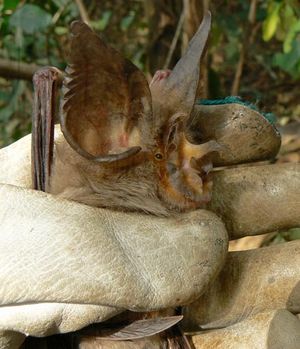Scientists found the twisted-faced creature, called the Maclaud's horseshoe bat, while surveying the highland forests of Guinea in West Africa this spring.
German biologist Natalie Weber took this picture after finding 16 members of the species in a series of remote caves. The bat had never been photographed before and had not been seen in the wild in nearly 40 years.
"Our rediscovery is good news insofar as the species is still there and as we have shown that the distribution range appears to be somewhat larger than previously known," said Jakob Fahr, an ecologist with Germany's University of Ulm, who coordinated the survey.
The Maclaud's bat is one of about 70 known species of horseshoe bats, so named for their distinctive - some might say grotesque - facial features called noseleafs.

|
| ©NG |
Scientists aren't certain what the skin flaps are for, but they're thought to aid in echolocation - the process bats use to navigate by emitting and receiving high-frequency sound waves.
"Nobody really knows," Fahr said of the leafy features. "All horseshoe bats possess these nasal structures, but [Maclaud's] has portions of the noseleaf modified in a unique way."
Like all of its frill-faced relatives, though, Maclaud's is susceptible to changes in its habitat, Fahr added. This makes conservation an urgent issue, as Guinea's forests start to come under pressure from mining interests.
"Most horseshoe bats react very sensitively to environmental disturbances," Fahr said.
"This region [of Guinea] is packed with mineral resources such as iron ore, and we fear that several of the pristine patches that still remain will be targeted by international mining companies."



Reader Comments
to our Newsletter